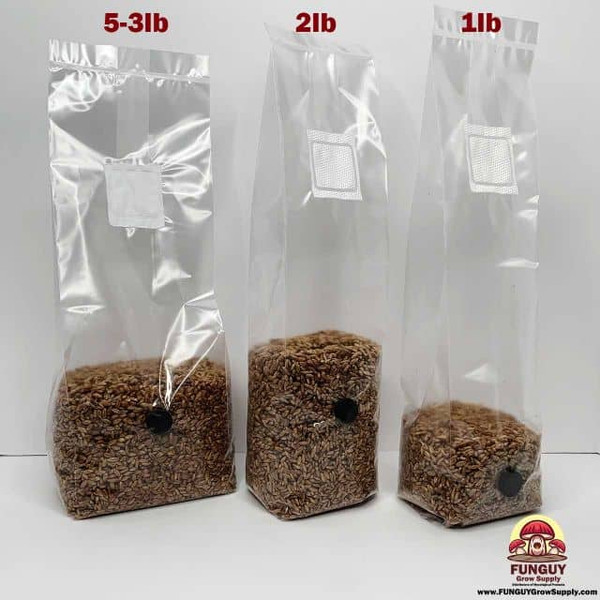Mushroom Grain Spawn: Ultimate Guide to Home Cultivation
Posted by Troy Cosky, Founder FunGuy Grow Supply on 22nd Jun 2023

Mastering the Art of Mushroom Cultivation: Exploring Grain Spawn Variants and Their Benefits
If you're interested in growing mushrooms at home, then understanding the importance of grain spawn is crucial. Grain spawn serves as a vital substrate for the mycelium to thrive and develop into mature fruiting bodies. By using this technique, you can grow a wide variety of organic mushroom strains with unique flavor profiles and textures.
One significant benefit of growing mushrooms at home using grain spawn is cost-effectiveness. You can save money by producing your own supply instead of buying them from stores or farmers' markets. Additionally, it offers customization options that cater to your taste preferences and dietary needs. Plus, there's nothing quite like the satisfaction of growing your own food right in your backyard.
In this article, we'll explore everything you need to know about the perfect grain spawn for home mushroom cultivation, including its benefits, variants, and tips for successful colonization.
Key Takeaways

- Grain spawn is essential for mushroom cultivation at home and allows for customization of taste and dietary preferences.
- Different types of grain spawns are available, including rye berry and brown rice, as well as specialty mycelium-based spawns for convenience and unique flavors.
- Organic mushroom grain spawn ensures a crop free from pesticides and harmful chemicals and provides access to unique mushroom strains.
- Successful grain spawn-making requires maintaining a sterile environment and periodically shaking jars for even distribution of mycelium, as well as proper storage for extended shelf life.
The Importance of Perfect Grain Mushroom Spawn in Home Mushroom Cultivation
Looking to cultivate delicious mushrooms at home? Well, let's start by introducing the essential component of successful mushroom growth: perfect grain spawn. Grain spawn plays a crucial role in controlled mushroom cultivation. It provides the mycelium, the vegetative part of the fungus, with a nutrient-rich substrate to grow and develop. By using mushroom spawn grain, you have access to a wide variety of organic mushroom strains with unique flavor profiles and textures.

One popular type of grain spawn is rye berry grain spawn. It's easy to prepare and works well for various types of mushrooms, including oyster mushroom spawn. To make rye berry grain spawn, you'll need rye berries, water, and a pressure cooker or boiling pot.
First, rinse the rye berries thoroughly with cold water before soaking them overnight. The next day, drain the water from the rye berries and place them in your pressure cooker or boiling pot with enough water to cover them by an inch or two. Cook for 45 minutes under pressure or until fully cooked if boiling on a stove.
After cooking your grains, it's time to inoculate them with mushroom spores, agar, or mycelium culture using sterile techniques that prevent contamination. You can then incubate your jars at temperatures ranging between 70-80°F for around 10 days until fully colonized by mycelium.
Once fully colonized with white web-like structures known as hyphae covering all grains inside your jar/container - called making mushroom spawn - you can use it as seed material for inoculating larger fruiting substrates such as sawdust blocks or straw bags.
Preparing grain spawn may seem complicated at first but once mastered, it becomes an essential skill for any home cultivator looking to produce high-quality mushrooms consistently. With cost-effectiveness being one of its benefits combined with customization options and satisfaction gained from growing your own food at home, there are no limits to what you can achieve.
Benefits of Grain Spawn for Growing Your Own Food
Growing your own mushrooms using nutrient-rich mycelium substrate offers a satisfying opportunity to customize unique flavor profiles and textures. Grain spawn is an essential ingredient for successful mushroom cultivation at home, providing the mycelium with the necessary nutrients to grow and thrive. Using grain mushroom spawn also allows you to access a diverse range of organic mushroom strains with distinct flavors and textures that are not always available in stores. Additionally, it is cost-effective as buying pre-grown mushrooms can be expensive.Table:
| Keyword | Definition |
|---|---|
| Grain Spawn | A nutritious substrate used for growing mushrooms, containing grains such as rye or wheat. |
| Mushrooms | Edible fungi are often used in cooking and are known for their unique flavor profile and texture. |
| Grain Mushroom Spawn | Refers to the grain-based material where mushroom spores are introduced to promote growth. |
| Mushroom Spawn Jars | Containers filled with sterilized grain spawn which provide an ideal environment for mushroom growth. |
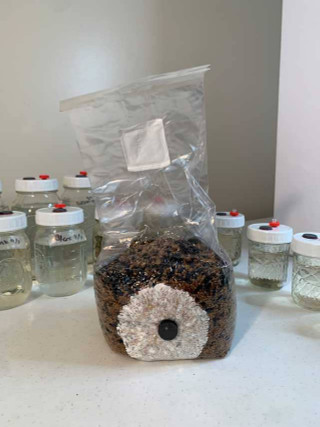
Furthermore, using grain spawn ensures consistency in your mushroom production at home since you have control over the quality of the substrate used during cultivation. You can also experiment with different types of substrates by mixing different grains or adding supplements like coffee grounds or sawdust. Buying high-quality grain spawn from reputable suppliers like FunGuy Grow Supply is crucial for successful cultivation as it guarantees that the product contains viable spores that will colonize properly.
Using grain spawn offers numerous benefits for successful mushroom cultivation at home, including customization, diversity of strains available, cost-effectiveness, consistency in production, and experimentation with different substrates. To maximize these benefits, it is essential to buy high-quality grain spawn jars from reputable suppliers like FunGuy Grow Supply before embarking on your mushroom-growing journey. In the next section about 'exploring organic mushroom grain spawn: analysis and benefits,' we will delve deeper into the different variants of grain spawn available in the market and their unique benefits.
Exploring Organic Mushroom Grain Spawn: Analysis and Benefits
By delving into the analysis and advantages of using organic grain spawn for mushroom growing, one can gain a deeper understanding of how to optimize their cultivation process. Organic mushroom grain spawn is a nutrient-rich substrate that provides mushrooms with the necessary foundation for growth and development. The use of high-quality, organic materials ensures that your crop will be free from contamination, providing a robust starting point for optimal yields.

To understand the benefits of using organic mushroom grain spawn, it's essential to know the different types available. Brown rice grain spawn is an excellent option as it's easy to make at home and offers cost-effectiveness compared to other variants. However, it's worth noting that other materials such as rye or wheat can also be used in creating grain spawn. Using certified-organic options guarantees that no synthetic chemicals were added during production.
Table: Popular Grain Options for Mushroom Spawn Production
| Grain Type | Advantages | Disadvantages |
|---|---|---|
| Rye Berry | High-yield potential; easy to find at most health stores and online retailers. | Can be expensive compared to other grain options. |
| Wheat Berries | Nutrient-dense; less prone to contamination than other grains. | May produce less yield compared to rye berry grain spawn. |
| Millet Seed | Low cost; fast colonization rate. | Not as nutrient-rich as rye or wheat berries. |
When using organic mushroom grain spawn, you'll notice several benefits over traditional methods like spore inoculation or cloning. Firstly, you'll have access to various strains with unique flavor profiles and textures not found elsewhere. Additionally, there's less room for error when using this method since the mushroom mycelium has already colonized the bulk substrate efficiently. Finally, by choosing an organic option, you're ensuring that your crop will be free from pesticides and harmful chemicals.
Overall, incorporating organic mushroom grain spawn into your cultivation process offers many benefits beyond just yield optimization; it provides access to unique flavors while being cost-effective and customizable. By following proper steps on how to make grain spawn at home or buying certified-organic variants online or in-store, you can create a successful operation without sacrificing quality.
Moving on to discussing 'mushroom spawn variants and their culinary impact,' understanding these different types' characteristics allows growers to choose which variant would best suit their needs in terms of flavor profile and yield optimization.
Mushroom Spawn Variants and Their Culinary Impact
Now, let's dive into the different types of mushroom spawn and how they can elevate your cooking game with unique flavors and textures.
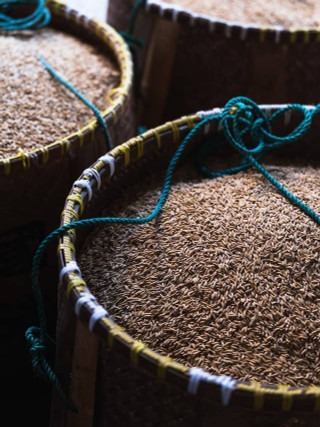
One type of grain spawn that's commonly used for cultivating oyster mushrooms is rye grain spawn. Rye grains are capable of absorbing more water than other grains, allowing for faster colonization of mycelium in the substrate. Additionally, rye grain contains essential nutrients that promote the healthy growth of the mushrooms. When cooked, oyster mushrooms grown from rye grain spawn have a mild nutty flavor that pairs well with seafood dishes.
Another popular variant of mushroom spawn is brown rice grain spawn. This type of grain spawn is known for its affordability and ease of use in making cakes for mushroom cultivation. Brown rice has a high starch content, which provides ample energy for mycelium growth and helps to maintain moisture levels in the substrate during incubation. When cooked, mushrooms grown from brown rice grain spawn have a subtle earthy taste that complements savory dishes like grilled meats or pasta.
Aside from traditional grain spawns, there are also specialty mycelium-based spawns available in the market such as mycelium-on-grain (MOG) or myco-bags. These pre-colonized substrate spawn bags offer convenience by eliminating the need to inoculate spores onto a separate growing medium before transferring them to final containers. One example of this type of mushroom spawn is oyster mushroom MOG, which boasts a rich umami flavor when cooked.
Choosing the right type of grain mushroom spawn can significantly impact the flavor profile and texture of your dish. Whether you prefer using tried-and-tested methods like rye or brown rice grain spawns or exploring new options like mycelium-based spawns, experimentation can lead to discovering exciting new culinary experiences with homegrown mushrooms!
Now that you have an idea about the different types of mushroom spawns available on the market, let's move on to how you can make your grain spawn at home.
Making Grain Spawn at Home: A Step-by-Step Guide
Ready to take your mushroom cultivation to the next level? Let's explore how to create your high-quality grain spawn at home! Making grain spawn is an essential step in growing mushrooms, and it's relatively easy to do with the right tools and techniques. Here are four steps you should follow when making grain spawn.

- Choose the Right Grains: Rye berries are a popular choice for making mushroom grain spawn because of their high nutrient content, but wheat, millet, and other grains can be used as well. Be sure to source your grains from reputable suppliers who offer organic and untreated options.
- Soak and Sterilize Your Grains: After selecting your grains, the first step in making grain spawn is soaking them overnight to hydrate them fully. Next, sterilize them using a pressure cooker or alternative methods like boiling or steam sterilization. Proper sterilization techniques are crucial to creating a sterile environment for mushroom mycelium growth.
- Inoculate with Mycelium Culture: Once your grains have cooled down after sterilization, inoculate them with mycelium culture obtained from spore syringes or liquid cultures using proper aseptic techniques.
- Allow Colonization of Grain Spawn: Finally, gently shake the mason jars containing the inoculated grains for even distribution of mycelium before leaving them in warm and dark areas until they're fully colonized.
Follow these instructions carefully when making grain spawn at home to ensure successful mushroom cultivation later on.
Now that you know how to make mushroom spawn through grain spawning, let's move on to discussing essential supplies and equipment needed for this process.
Essential Supplies and Equipment for Grain Spawn Making
Are you eager to start growing your own mushrooms? Let's talk about the essential supplies and equipment you'll need for successful grain spawn-making!
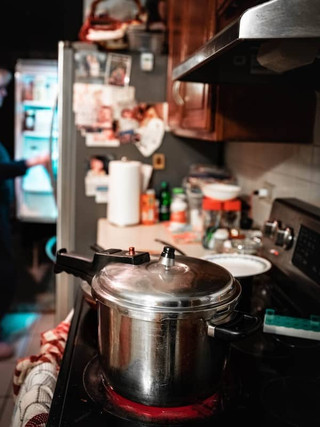
First, you'll need the right type of grain jars. Glass jars are commonly used, but mushroom grow bags can also be used for bulk production. Rye berries, wheat berries, millet, and popcorn kernels are commonly used grains for preparing rye grain spawn.
Next on the list is sterilizing your grain spawn. Sterilization is critical in ensuring that no unwanted bacteria or fungi contaminate your mushroom spawn. A pressure cooker is the preferred method for sterilizing grains due to its high temperature and pressure capacity. However, if a pressure cooker isn't available, steam baths or oven baking are alternative methods that can still be effective.
When it comes to purchasing materials like grain jars and mushroom spawns for sale, there are many options available online. Consider buying from reputable suppliers with good reviews to ensure quality products. Additionally, search for 'mushroom spawn suppliers near me' to find local businesses offering these mushroom cultivation supplies. This may save on shipping costs while supporting local communities.
Another important item on your checklist is mushroom spores or culture. These are what you'll use to inoculate your sterilized grains with spores or mycelium. Mushroom spores come in different varieties depending on the type of mushroom species you want to grow. Alternatively, liquid culture offers convenience and efficiency because it eliminates the need for spores.
Essential supplies and equipment needed for successful grain spawn-making include glass jars or grow bags, clean grains like rye berries or popcorn kernels, a pressure cooker (or alternative sterilization method), and either mushroom spores or culture.
Now that we've gone over these basics, let's move on to some tips for successful colonization without delay!
Tips for Successful Colonization of Grain Spawn
Now that you have all the essential supplies and equipment for making grain spawn, it's time to focus on successful colonization. This is a crucial step in the process of growing oyster mushrooms at home, as it determines the yield and quality of your harvest.

To help you achieve optimal results, here are some tips to keep in mind:
- Sanitize everything: Before starting the colonization process, make sure to sanitize all surfaces, tools, and containers thoroughly. This will minimize the risk of contamination and ensure a sterile environment for your mycelium to grow.
- Shake gently: Periodically shaking your colonized grain spawn jars helps distribute the mycelium evenly throughout the substrate, promoting faster colonization and maximizing yield. However, be careful not to shake too vigorously as this may damage the delicate mycelium.
- Monitor closely: Contamination can be a common issue during grain spawn production. Keep a close eye on your jars and look out for any signs of mold or other unwanted growth. If contamination does occur, address it promptly to prevent further spread.
- Be patient: Successful colonization takes time – typically around 10-14 days depending on temperature and humidity levels – so don't rush the process or try to cut corners. Trust in your technique and give your mycelium plenty of time to establish itself before moving on to fruiting.
By following these tips for successful colonization, you'll be well on your way to producing high-quality grain spawn for home mushroom cultivation.
Storage and Usage Guidelines for Maintaining Grain Spawn Quality
Ensure your hard work isn't wasted by properly storing and utilizing your colonized grain spawn. This maximizes the potential for a successful and fruitful mushroom cultivation experience. Here are some storage guidelines to keep in mind:
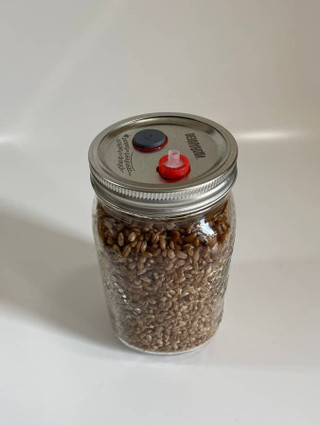
- Cool and Dry Storage: Store your fully colonized grain spawn in an air-tight container or bag in a cool and dry place to maintain its viability and potency. The ideal temperature range is between 2-8°C (35-46°F), with a relative humidity of less than 50%. Avoid exposing the grain spawn to direct sunlight or moisture, as this can cause contamination or spoilage.
- Shelf Life Variants: Different types of mushroom spawns have different shelf lives, ranging from a few weeks to several months. For instance, Agaricus bisporus has a shorter shelf life compared to shiitake or oyster mushrooms. It's important to plan your cultivation accordingly based on the expected shelf life of your chosen mushroom species, taking into account varying shelf life.
- Usage Guidelines: Use the grain spawn within a specific timeframe, ideally within three months after colonization, to ensure optimal results. If you store it for too long, it may lose potency or become contaminated, leading to poor yield during cultivation. Remember, the timeline varies depending on the type of mushroom you're growing and other environmental factors such as temperature and humidity levels. You can use the grain spawn immediately after colonization or store it in an air-tight container until ready for use, being aware of the importance of preventing mold growth and maintaining potency.
Proper storage and usage guidelines are essential for maintaining the potency of your mushroom spawn and ensuring optimal yield during cultivation. With these tips in mind, you're well on your way to becoming a successful homegrown mushroom farmer and achieving high-quality yields. By paying attention to details and showing patience and persistence, you can overcome any risk of contamination or loss of potency over time.
Conclusion: Embarking on a Mushroom Cultivation Journey
By following these simple guidelines, you can increase your chances of a successful and fruitful mushroom cultivation experience in the comfort of your own home.

Once you've prepared your grain spawn, it's important to store it properly to maintain its quality. Keep the bags in a cool, dry place away from direct sunlight until you're ready to use them. It's recommended that you use the grain spawn within six months of preparation for optimal results.
If you don't plan on using your grain spawn immediately, you can freeze it to extend its shelf life. Simply place the bags in a freezer set at -18 degrees Celsius or lower. When thawing the bags, make sure they're completely defrosted before inoculating with spores or tissue cultures. This will prevent any ice crystals from forming and damaging the grains.
To ensure success when using your grain spawn for mushroom cultivation, be sure to purchase high-quality products from reputable suppliers such as oyster mushrooms grain spawn or the best mushroom spawn suppliers. Using inferior quality products can lead to contamination and poor yields. It's also important to follow proper sterilization techniques when working with your grain spawn and other mushroom cultivation materials.
Perfecting your grain spawn production is essential for successful mushroom cultivation at home. Follow proper storage and usage guidelines closely to maintain the quality of the product and reduce contamination risks. Always purchase high-quality products from reputable suppliers like oyster mushroom grain spawn or the best mushroom spawn suppliers, follow proper sterilization techniques during all stages of production, and enjoy bountiful harvests of delicious and nutritious mushrooms in the comfort of your own home!
Explore Our Mushroom Growing Kits, Grain Spawn, and All In One Mushroom Grow Bags at FunGuy Grow Supply!
Take your mushroom cultivation to the next level with our premium grain spawn, mushroom growing kits, and all in one grow bags. FunGuy Grow Supply offers top-quality products that are essential for successful mushroom growing at home. Visit our store today and equip yourself with the best supplies for a bountiful harvest!
Frequently Asked Questions

Can you use any type of grain for making grain spawn?
Yes, you can use various types of grains for making grain spawn. However, some grains are more suitable than others due to their nutritional value and ability to support the growth of mycelium.
Commonly used grains include rye, wheat berries, millet, and corn. Rye is a popular choice because it's high in protein and has a good balance of amino acids necessary for fungal growth. Wheat berries are also a good option as they have a high starch content that provides energy for mycelial growth.
Millet and corn are less commonly used but can be effective with proper preparation. It's important to choose high-quality grains without any contaminants or chemicals that could harm the mycelium.
How long does it take for grain spawn to colonize?
Grain spawn colonization time varies depending on the type of grain, the temperature, and the variety of mushroom species. Typically, it takes between one to three weeks for grain spawn to fully colonize. However, some varieties may take up to five weeks or longer.
It's important to maintain proper humidity levels and temperature during this process as both can affect the speed of colonization. Additionally, using high-quality grains and sterilizing them properly will help ensure a faster colonization time.
Can you freeze grain spawn for later use?
Yes, you can freeze grain spawn for later use. Freezing is a common method used to store mushroom cultures, and it can extend the lifespan of your grain spawn.
To freeze your grain spawn, you should first prepare it as usual and then transfer it into sterile containers. Make sure to label each container with the date and type of mushroom strain used.
Once labeled, place the containers in a freezer set at -20°C or lower. When you're ready to use your frozen grain spawn, simply thaw it out at room temperature and then inoculate your bulk substrate as usual.
Keep in mind that freezing can reduce the viability of your culture over time, so try to use it within six months for the best results.
How do you know if your grain spawn is contaminated?
To determine if your grain spawn is contaminated, there are a few signs you should look out for. Firstly, a foul odor emanating from the container is an indicator that something has gone wrong.
Secondly, discoloration of the grains or mycelium could suggest the presence of harmful bacteria or fungi.
Thirdly, if you notice any unusual growth patterns or formations on the surface of the grains or in the surrounding area, it may be a sign of contamination.
Finally, if your mushroom growth seems stunted or abnormal compared to previous batches, this could also indicate contamination.
To prevent contamination in the first place, make sure to sterilize all equipment and work surfaces before handling your grain spawn and maintain sterile conditions throughout the cultivation process.
Can you reuse grain spawn for multiple mushroom grows?
Yes, you can reuse grain spawn for multiple mushroom grows. However, it's important to note that the effectiveness of the reused spawn will decrease with each use.
This is because each time the spawn is used, it loses some of its nutrients and becomes less potent. To ensure a successful harvest, it's recommended to only reuse grain spawn up to two or three times before starting with fresh spawn.
Additionally, it's crucial to properly sterilize the reused spawn before using it again to prevent contamination and reduce the risk of failed crops.
References
- Sánchez, C. (2010). Cultivation of Pleurotus ostreatus and other edible mushrooms. Applied microbiology and biotechnology, 85(5), 1321–1337. https://doi.org/10.1007/s00253-009-2343-7
- Hoa, H. T., Wang, C. L., & Wang, C. H. (2015). The Effects of Different Substrates on the Growth, Yield, and Nutritional Composition of Two Oyster Mushrooms (Pleurotus ostreatus and Pleurotus cystidiosus). Mycobiology, 43(4), 423–434. https://doi.org/10.5941/MYCO.2015.43.4.423
- Kumla, J., Suwannarach, N., Sujarit, K., Penkhrue, W., Kakumyan, P., Jatuwong, K., Vadthanarat, S., & Lumyong, S. (2020). Cultivation of Mushrooms and Their Lignocellulolytic Enzyme Production Through the Utilization of Agro-Industrial Waste. Molecules (Basel, Switzerland), 25(12), 2811. https://doi.org/10.3390/molecules25122811
- Suwannarach, N., Kumla, J., Zhao, Y., & Kakumyan, P. (2022). Impact of Cultivation Substrate and Microbial Community on Improving Mushroom Productivity: A Review. Biology, 11(4), 569. https://doi.org/10.3390/biology11040569

